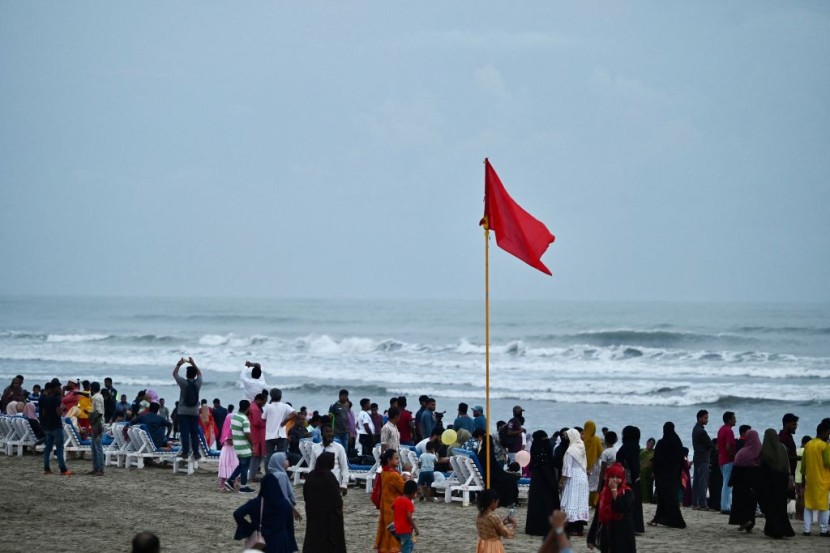
On Sunday, a cyclone predicted to be the strongest to strike Myanmar in over a decade is anticipated to land near the Bangladeshi border, heightening the possibility of a major humanitarian catastrophe.
Cyclone Mocha formed over the southern Bay of Bengal on Thursday, drenching western Myanmar as it churned northeast on Saturday. According to the Global Disaster Alert and Coordination System, heavy rain, high winds, and storm surges are expected to persist through Sunday.
Cyclone Mocha Now 'Very Severe'
Myanmar and Bangladesh began deploying thousands of volunteers and ordering evacuations from low-lying areas in a region home to some of the world's poorest people, particularly susceptible to increasingly severe weather events.
Per NY Times, authorities in Bangladesh have instructed fishermen in the Bay of Bengal to remain close to shore. Azizur Rahman, director of the Bangladesh Meteorological Department, predicted Friday that the coastal areas of Bangladesh will experience significant rainfall beginning Saturday afternoon.
The World Meteorological Organisation warned of violent gusts, flooding, and potential landslides in Bangladesh, which could strike the world's largest refugee camp in Cox's Bazaar. India's meteorological office forecasts that Cyclone Mocha will land on Sunday near the Bangladesh-Myanmar border, carrying winds of up to 175 kilometers per hour (108mph).
The office predicted a storm surge of two to two-and-a-half meters (six to eight feet) for the low-lying coastal region, which on the Bangladeshi side is home to vast refugee settlements containing hundreds of thousands of Rohingya refugees.
In 2017, the majority of them escaped Myanmar after a military-led crackdown. Olga Sarrado, the spokesperson for the UN refugee agency, stated that preparations were underway for a possible partial evacuation of the camp. Per The Guardian, she stated that the organization was also preparing tens of thousands of heated meals and jerrycans.
The World Health Organization stated that 33 mobile medical teams, 40 ambulances, and emergency surgery and cholera supplies were being prepositioned for the camp. In Myanmar, the WHO prepositioned 500,000 water purification tablets in addition to other supplies representing the entire monsoon season's supply. Some laid out blankets and designated sleeping areas while unpacking supplies.
According to state media, Myanmar's junta authorities supervised the evacuation of coastal villages along the Rakhine coast, which did not indicate how many people had been relocated.
The junta stated that any vessels leaving the Rakhine coast after Friday afternoon would be subject to legal action. On Friday, the United Nations Office for humanitarian affairs warned that heavy gusts and rain could provoke flooding and landslides in Myanmar and Bangladesh's interior.
Approximately 6 million people in Rakhine and the northwestern region of Myanmar already needed humanitarian assistance, it was noted. Bangladesh had not initiated any evacuations, but officials reported that hundreds of cyclone shelters were prepared to house evacuees.
Read Also : G7 Summit Targets China's Economic Coercion; Beijing Displays Military Power Around Japan
Tropical Cyclones in Myanmar, Bangladesh
In November 2007, Cyclone Sidr devastated the southwestern region of Bangladesh, murdering more than 3,000 people and inflicting billions of dollars in damage.
Meanwhile, Maarutha was the last tropical cyclone to land in Myanmar in April 2017. Even though Maarutha made landfall as a tropical storm with maximum winds of 92 kilometers per hour (58 miles per hour), it brought torrential rains and damaged nearly 100 dwellings.
In October 2010, Tropical Cyclone Giri was the last storm with hurricane-force winds to land. It made landfall as a Category 4 cyclone with maximal winds of 250 kilometers per hour (155 mph), according to CNN. Over 150 people were killed, and approximately 70 percent of Kyaukphyu in Rakhine was devastated when Giri struck. According to the United Nations, the storm destroyed about 15,000 dwellings in the province.
According to humanitarian agencies, the worst natural calamity to strike Myanmar was Cyclone Nargis in May 2008, which killed 140,000 people, severely affected 2.4 million, and displaced 800,000.
© 2025 HNGN, All rights reserved. Do not reproduce without permission.








